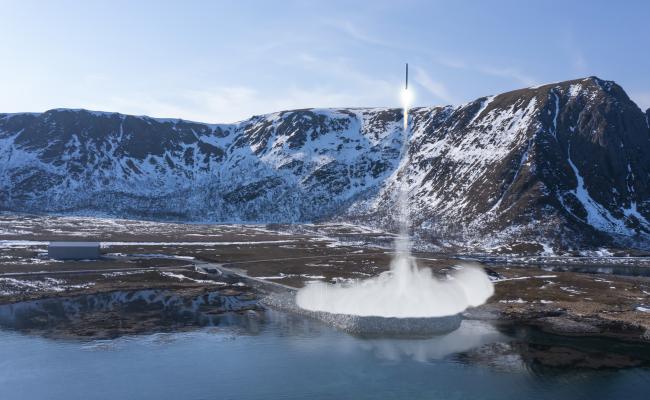High North Dialogue 2025: Increase in Satellites Pollutes Our Night Sky and Atmosphere, Says Researcher
Michael Byers, a professor at the University of British Columbia, visited Bodø in Northern Norway for the High North Dialogue conference. He took part in a session on the High North and space. (Photo: Birgitte Annie Hansen)
Bodø (High North News): Space activities are increasing at an exponential pace, also above the Arctic. From about 2,000 satellites in 2015 to 12,000 today, satellites represent significant light pollution of the Arctic and global sky. "If the sky for our children and grandchildren is a sky of satellites, they would be losing the connection with the universe," says Canadian legal scholar Michael Byers to HNN.
"We are talking about an earth-space environmental system here. We must be conscious that everything we put up will put more of a load on that system. We have to figure out how to develop space that is safe and environmentally sustainable," says Dr. Michael Byers.
Byers is a professor of Global Politics and International Law at the University of British Columbia and holds the Canada Research Chair in Global Politics and International Law. He is also the co-director of the Outer Space Institute (OSI). The professor visited Bodø, Northern Norway, for the High North Dialogue conference.
"If we're not smart, we will screw up space, just like we screwed up parts of our planet," he stated during a conference session titled "New Realities: The High North in New Space."
High North News met with Byers to talk about the rapid increase of satellites orbiting Earth, the light pollution they represent, and the risk of space debris ruining the ozone layer.
Non-regulated light pollution
Light pollution is the human-made alteration of outdoor light levels from those occurring naturally. It most commonly refers to light pollution on Earth, which can negatively affect wildlife and ecosystems, human health, energy, and climate change.
However, an increasing number of satellites is now becoming a source of light pollution from above, threatening the cultural heritage of the night sky.
Most satellites are solar-powered, meaning they reflect sunlight even when it is nighttime on Earth. Since satellites are much closer to us than the stars and planets, the reflected light can be stronger than that of the other objects visible to us in the night sky.
True dark and quiet skies are in short supply, and many people will never experience a truly dark sky devoid of light pollution in their lifetime. Dark skies are important for animals, such as migratory birds, and hold cultural significance not only to Indigenous peoples but also to people in general, who are becoming more disconnected from the universe as stargazing becomes more and more difficult.
Yet, there are no regulations concerned with reducing light pollution in our night skies, says Dr. Byers to HNN.
The aesthetic value of the dark sky holds little significance when compared to the value of cell service, climate change surveillance, forest fire detection, fisheries enforcement, weather data, and GPS.
Astronomers pushing back
Light pollution also poses significant challenges for astronomers. Since satellites are moving, they can create streaks of light across images. They can also be in the line of vision when telescopes are trying to look at objects millions of lightyears away, blocking the view at distances of just 500 kilometers, a phenomenon called occultation.
The satellites also cause radio interference, as radio transmissions can swamp the radio waves astronomers use to learn about space.
"The governments have invested many billions of euros into observatories and telescopes. The amount of public money that has gone to astronomy is much greater than the money in the space industry. So why is this relatively small industry allowed to affect this decades-long public investment in science?" asks Byers.
He explains that the astronomers are very organized and have put this issue on the UN agenda, using the term "dark and quiet skies."
Why is this relatively small industry allowed to affect this decades-long public investment in science?
SpaceX unreliability
Out of the 12,003 objects currently orbiting Earth, about 8,000 belong to SpaceX.
"Several years ago, the US Government told SpaceX that it should work with astronomers to try to reduce its light pollution. SpaceX tried painting their satellites black, but then they got really hot. So then they tried to put visors on them to shield the reflection, but then they realized they wanted to have laser connections between their different satellites, so they had to take the visors off," Byers explains and continues:
"To be fair, they have managed to reduce some of the light pollution. But there are plans to have hundreds of thousands of satellites, and some companies want to have huge satellites, especially for direct-to-cell services, meaning the satellite would connect directly to your cellphone."
In many cases, these would be as bright as some of the stars, he says.
"Thus, the problem is actually getting worse, not better. And there are no regulations."
Byers also highlights the issue of SpaceX's Elon Musk, his unpredictability, as well as his close relationship with the Trump administration.
"Does he care about the night sky? Can we trust him to protect this cultural heritage? And can we expect the Trump administration to regulate SpaceX? I am very doubtful that there will be any constraints on SpaceX for the next few years," he states.
Andøya Space
The significance of European spaceports, such as Andøya Space in Northern Norway, has increased since Trump took office. With the United States' unreliability, having a non-American redundancy is more important than ever.
"SpaceX has the majority of satellites, and it is able to launch 55 of them at a time at 750kg each. They are moving quickly and with no effective regulation. The head of the company is right beside Donald Trump, so it is a difficult time," says Byers.
"There is a question now as to whether we can rely upon the United States and American companies. There are still other options, but it's good that there will be a launch site in Europe with additional capacity," he says.
Andøya Space is currently waiting to conduct a test flight for the German company Isar Aerospace's launch vehicle Spectrum. The launch was supposed to take place on Monday, but due to poor weather conditions, it has been postponed to Saturday at the earliest. If they succeed, Spectrum will be the first orbital launch vehicle to be launched from the European continent.
Does Musk care about the night sky?
A sky of satellites
In what could only be called a paradox, the increase in space activities and satellites makes us "lose our connection to the universe," says Byers. While not opposed to the space industry, Byers sees this as one of the negative consequences or externalities.
"If the sky for our children and grandchildren is a sky of satellites, they would be losing the connection with the universe. It closes our universe, it makes it smaller," says Byers.
There are currently programs that work toward protecting and preserving areas through responsible lighting policies, such as International Dark Sky Places (IDSP). Still, such places cannot be protected against satellite light pollution, only from the ground.
"This also affects tourism. People and countries have been trying to develop dark sky tourism, but now we have the satellites," says Beyers and continues:
"We need much more attention done to reducing the light and radio pollution, and we probably need governance to take this more seriously and have regulations," he says.
He says that there will still be negative impacts, as every industrial activity has negative impacts, but that we cannot have an entire industry that is uncontrolled regarding this issue.
The High North Dialogue session New Realities: The High North in New Space. From the left: Therese Kristiansen, Director People & Organization, KSAT – Kongsberg Satellite Service; Ole Dokka, Founder & Executive Director, Spaceport Norway; Moderator Anu Fredrikson, Executive Director, Arctic Frontiers; Dr. Michael Byers, Professor of Global Politics and International Law, University of British Columbia and Kolbjørn Blix, Vice President, Andøya Space. (Photo: Birgitte Annie Hansen)
The ozone layer at risk once again
Satellites return and enter the atmosphere at the end of their life span. They are designed to turn into millions of particles.
"When someone says a satellite 'burns up,' it does not disappear; it just turns into millions of particles," says Byers, explaining that NASA sampling of stratospheric air found unusual levels of aluminum, which is what satellites are mostly made of.
"We don't know what these changes will do, but the biggest threat is likely to the ozone layer. We saved the ozone layer through the Montreal Protocol, but now we might have a new threat," says Byers.
The scholar explains that in most countries, space debris must be brought back within 25 years of its end of life. In some countries, it's just five years.
"But they have to bring it back into the atmosphere. The recommended approach is for the space debris to 'burn up,' but now the scientists see this could be a bad idea."
Into the ocean
Some are now thinking that the best approach to space debris is to design satellites that do not burn up but rather steer and deposit them in a remote area of the ocean.
"This will still have environmental impacts, but it might not be as bad," says Byers, adding that no one really knows the consequences yet.
"Space is part of the human environment. It is not different, it's connected. We used to think the ocean was so big that we could throw garbage into it, we used to think the atmosphere was so big that we could dump all kinds of carbon dioxide in it. But every region has its limits," concludes Byers.



